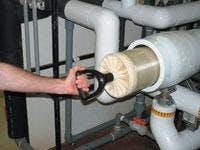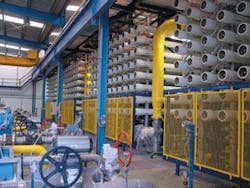Desalination: Coupling technology locks out leaks in Lanzarote
Dr. Jon Johnson, Markus Busch
A desalination plant in the Canary Islands tests an alternative coupling option that resulted in reduced permeate conductivity, contamination, and lower operating costs.
In reverse osmosis (RO), connections between system elements are generally made with the decades-old method of sliding couplers. These couplers increase energy costs by restricting flow and contain multiple sliding surfaces that abrade easily causing costly leaks. Consequently, some RO plants are turning to a new element coupling technology.
Sliding couplers are segments of pipe with radially compressed o-rings used to connect product water tubes on adjacent elements. Although widely used, this coupling design contains many inherent drawbacks that impair RO performance and add costs. O-rings are frequently pinched, rolled or twisted during installation, potentially causing costly leaks and product water contamination. To run at optimum efficiency, traditional couplers require an oil-based lubricant, a problem in plants producing ultrapure water. Also, due to the fact that the inside diameter of the coupler is smaller than that of the pipes it connects, traditional couplers increase flow resistance, and in turn, energy consumption and costs.
From leaky to leak-free
Lanzarote is the furthest east of the seven major Canary Islands, sixty miles off the coast of Africa. The island relies largely on reverse osmosis conversion of seawater to support its tourist, domestic, and agricultural activities. The RO operations on Lanzarote are owned and operated by Insular de Aguas de Lanzarote S.A. (Inalsa), which provides water production, distribution, and recycling services, in addition to wastewater treatment, to more than 40,000 customers. The plant produces 20,000 m3/d (5 million gpd) of permeate at a concentration of 430 ppm from four RO trains.
Inalsa’s Lanzarote RO plant has had recurring problems with o-ring leakage, resulting in the failure of three vessels per train per month. Approximately 18 man-hours per month were dedicated to repairing these leaks on each of the trains. The five-year net present value of this expenditure was US$ 21,000 and would have been much higher if the plant had been operating at capacity and was subject to monetary losses during shutdown.
To help eliminate the problem and reduce costs, the Lanzarote plant conducted a field test of twelve elements with patented iLEC interlocking endcaps to determine the effects on permeate quality and on ease of installation and removal. A critical question was whether the iLEC couplers would integrate with the couplers currently in use.
FilmTec elements with iLEC interlocking endcaps were installed in two vessels at the plant. Upon start-up, the vessel in Stage 1 produced permeate containing 95 ppm of total dissolved solids (TDS), at an average flux of 20 Lmh (11.8 gfd), while the vessel in Stage 2 produced permeate containing 270 ppm TDS at an average flux of 7.8 Lmh (4.6 gfd). Sustained performance at this level requires standard-test rejection of 99.85 percent and perfect sealing between elements.
The operating personnel at Lanzarote rated the iLEC elements easier to install and “less work” than standard elements, in part because there was no need to handle interconnectors. They also noted that interlocking vessel adapters were readily attached to the first and last elements in both vessels using the new couplers. Interlocking tabs around the periphery of each iLEC endcap snapped together to provide a fixed mechanical connection between elements. According to the plant workers, the snapping action makes it easy to tell when a connection is successful even in the noisy plant environment. This allowed the installation to be completed without a time-consuming search for leaks upon start-up. More than a year after installation, the iLEC vessels at the Lanzarote plant remained leak-free.
As the success at the Lanzarote plant shows, an effective way to improve water quality and lower operating costs in an RO plant is to invest in updated coupling technology to reduce energy-consuming flow resistance and o-ring leakage.
Authors’ Note
Dr. Jon Johnson is a research specialist with FilmTec Corporation, a subsidiary of the Dow Chemical Company. His current projects include the design of membrane elements and their component parts, focusing on improved methods of sealing and the mechanical interactions between elements. A second area of research is the tradeoff between pressure drop and mass transfer in feed spacer materials. Dr. Johnson received a Ph.D. in Mechanical Engineering from the University of Minnesota.
Markus Busch is an environmental engineer with specialty water treatment from the University of Berlin. Currently, his position is technical service and development leader at Dow Deutschland GmbH & Co OHG. He is leading the development project for new FilmTec seawater products and the German test laboratory for membranes and ion exchange resins. Web site: www.filmtec.com



